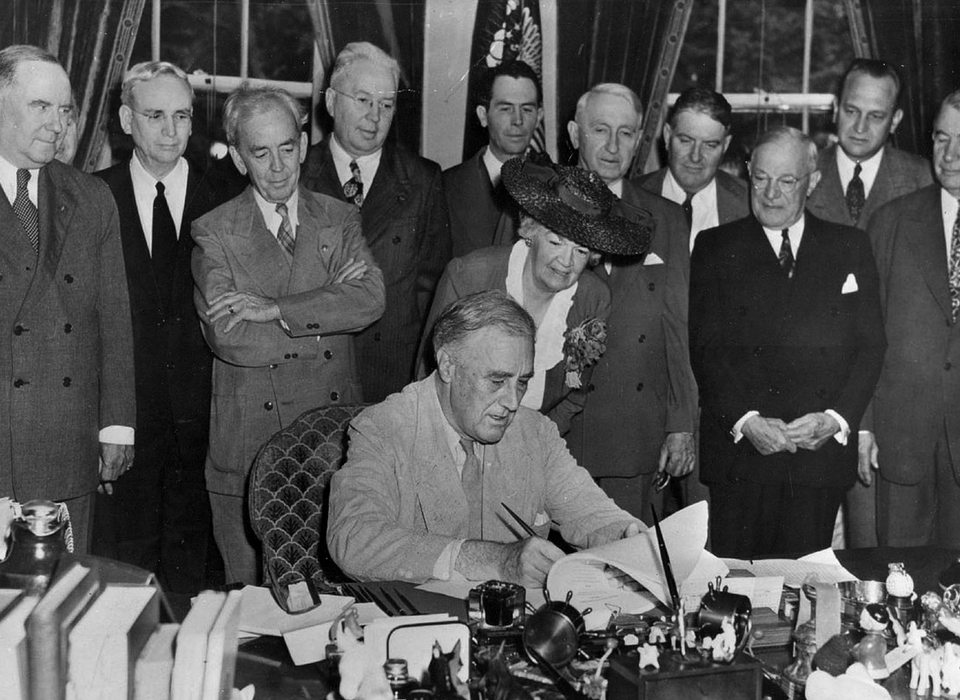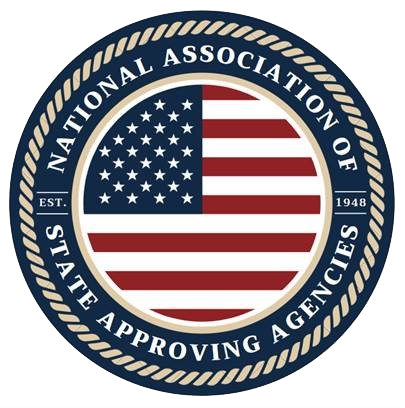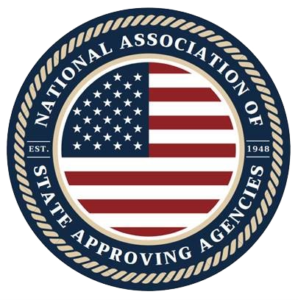The National Association of State Approving Agencies (NASAA) helps make the GI Bill work. NASAA facilitates the efforts of its member State Approving Agencies (SAAs) in promoting and safeguarding quality education and training programs for veterans, ensuring greater education and training opportunities for veterans, and protecting the integrity of the GI Bill.
NASAA is made up of more than 50 state agencies nationwide that oversee education and training programs for veterans in their respective states. Most states have a single agency to evaluate, approve, and monitor education and training programs for use by GI Bill-eligible students. One state, Washington, has two separate SAAs for different types of training (schools vs. on-job, for example). SAAs provide assistance to schools and training facilities that are approved or are seeking approval. SAAs’ approval decisions are transmitted to the U.S. Department of Veterans Affairs so that VA can pay benefits when students enroll. SAAs play a major role in monitoring schools with approved programs to assure they continue to comply with state and federal law.
NASAA works hand-in-hand with other organizations to make the GI Bill the best possible educational assistance program for our nation’s veterans. NASAA members work with government agencies, Congress, schools, and employers to assure that veterans have access to well-managed, ethical programs they can trust to help them achieve their goals.
A Little History
In 1948, the State Approving Agencies saw a need to coordinate their efforts nationwide and gathered to form the National Association of State Approving Agencies. Then, as of now, NASAA assisted states in their efforts to do a better job for veteran students and served as a tool to resolve mutual problems. NASAA and SAAs have been an outstanding example of the success of a State-Federal partnership that allows Federal interests to be pursued at the local level while preserving the identity, interests, and sovereignty of States’ rights in education. NASAA also has increased its influence in the realms of education and veterans benefits over the years, playing major roles in the creation of new programs, such as the Montgomery GI Bill and the Post 9/11 GI Bill.
The primary focus of the SAAs continues to be the review, evaluation, and approval of quality programs of education and training under State and Federal criteria. SAAs continue to conduct on-site technical assistance and compliance visits to approved institutions and to those seeking approval. SAAs engage in outreach activities to encourage wider use of the GI Bill, by veterans, other beneficiaries, schools, and employers. Many SAAs also act as state liaisons, helping military installations provide base personnel with quality educational offerings and information about education benefits.
Yet, while their fundamental role has remained the same, SAAs have evolved in response to the changes in our society over the years since World War II. SAAs and NASAA have become advocates for quality education and training for veterans and other eligible persons. They have become educational partners with the institutions themselves, facilitating even greater and more diverse educational opportunities for veterans. They have become strong advocates for the usage of the GI Bill and have developed a working partnership with the federal government which other federal agencies have tried to emulate.
With changing state and national priorities and a continuous re-examination of the function of government, as well as the evolving needs of our veterans, service members, and their families, state approving agencies stand ready to meet challenges head-on. Furthermore, in spite of the need for new approaches and technologies, differing styles of oversight, and enhanced criteria for performance, the fundamental reasons for which the SAAs were originally created remain as valid today as they were in the beginning.
Executive Board Members

Frank Myers
South Carolina SAA

Rebecca Ryan
Rhode Island SAA

John Murray
Washington SAA

Tramaine Carroll-Payne
Virginia SAA

Andrew Martin
Wisconsin SAA

Joe Wescott
North Carolina SAA

Chris Garcia
Texas SAA

Everette Jackson, Jr.
Maryland SAA

Edward Godfrey
Minnesota SAA

Lily Snyder
Georgia SAA

Katherine Snyder
New Mexico SAA

Michael Criscuolo
Connecticut SAA
Ex Officio Member

James Henley
Missouri SAA
Ex Officio Member
Greetings from the President
September 12, 2022
With the implementation of Public Law 116-315-Sections-1010 through 1020, and the rising cost of tuition and fees each academic year, the GI Bill® could be a primary focal point for many for- profit educational institutions to launch various media advertisements to attract and persuade veterans and their family members to use their GI Bill® Benefits at their institutions.
Every educational institution must be held accountable not only for the enrollment of VA recipients, but for all students’ financial contributions. Accountability to hold each educational institution responsible for their mischievous actions is less than a favorable return for our tax-payers’ dollars and more importantly, for the investment that our veterans have made to this great country.
On January 5, 2021, the President signed the Johnny Isakson and David P. Roe, M.D. Veterans Health Care and Benefits Improvement Act of 2020 (P.L.116-315) into law. This new law brings significant changes to Veterans’ education benefits. Many of the changes enhance or expand education benefits for Veterans, Service members, families and survivors and provide for the improvement and/or expansion of various GI Bill® programs.
On October 1, 2022, the National Association of State Approving Agencies (NASAA) will transition from conducting compliance surveys to risk based surveys. NASAA looks forward to our new role and our ongoing collaboration with our VA partners and various veteran service organizations to ensure educational institutions adhere to Public Law 116-315.
As a result of the implementation of Public Law 116-315, Sections 1010 and 1019 will help in reducing the amount of over and underpayment to veterans and their family members.
“Education is the most powerful weapon which you can use to change the world.” Education is the key to eliminating gender inequality, to reducing poverty, to creating a sustainable planet, to preventing needless deaths and illness, and to fostering peace (Nelson Mandela).”
Freedom is not free. Veterans have protected our freedom and democracy, and many have paid the ultimate sacrifice for our nation. As the gatekeepers for existing and new educational institutions to become approved to offer veterans education and training, NASAA will take the appropriate actions necessary against those entities that attract veterans and their family members that use advertising, sales, enrollment practices, or candidate handbooks that are erroneous, deceptive, or misleading by actual statement, omission, or intimation.
NASAA was established in 1948 and will celebrate its 75th anniversary during the 2023 NASAA Summer Conference that will be held in Stowe, Vermont.
NASAA is comprised of 53 State Approving Agencies with over 200 professional and support staff members. As President, I am grateful to have this opportunity to lead and serve NASAA to ensure veterans and their family members continues to receive quality education and training.
I am elated to have this opportunity to work with such phenomenal people in NASAA, our VA partners and veteran service organizations to continue to protect the integrity of the GI Bill® Educational Benefits!
Sincerely,
Frank G. Myers, Jr.
NASAA President
Timeline
June 22, 1944

1945
January 1, 1947
The first contracts are signed between the federal government and the individual State Approval Agencies, marking the beginning of an important federal-state relationship that continues through the present day.
That same year, veterans attending school on the GI Bill comprise 49% of the nation’s higher education population.

